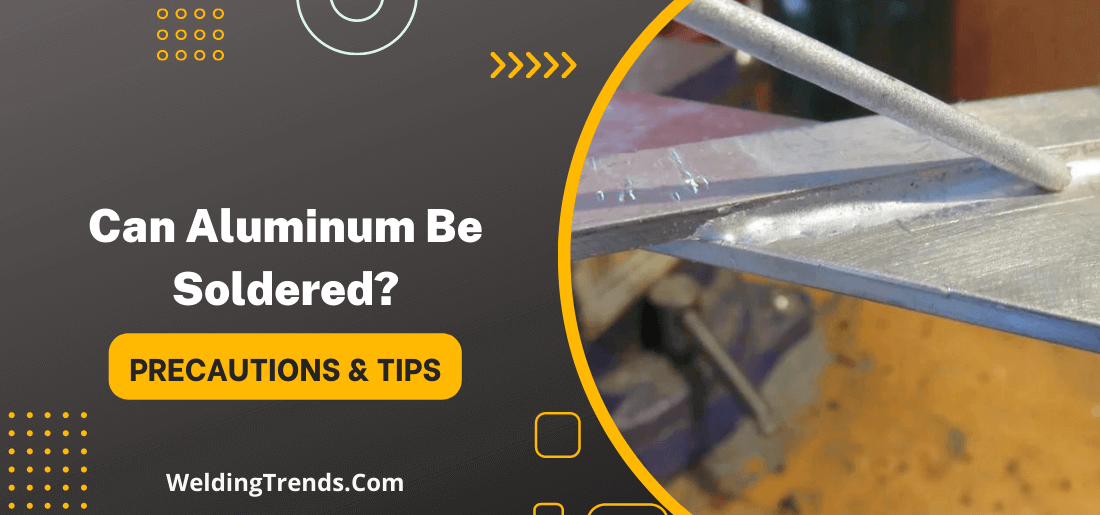Yes, aluminum can be soldered, but the process is a bit more complicated than soldering other metals. To solder aluminum, you will need to use a special flux and alloy wire.
Be sure to practice on a scrap piece of aluminum before trying to solder an important project. The results may not be perfect but with some patience and practice, you should be able to get the job done.
Let’s take a closer look at what makes aluminum solder an attractive option and some tips for using it successfully.
What is soldering aluminum?
Soldering aluminum is a process of joining two pieces of aluminum together using a molten filler metal. This can be done for a variety of reasons, including repairing damaged items, creating new structures, or electrical conductivity.
The process can be done with a variety of different metals, but the most common is tin. This is because it has a low melting point and wetting ability, which makes it easy to use. It also doesn’t react with aluminum, so there is no risk of corrosion.
There are several benefits to soldering aluminum:
- It is a relatively simple process that doesn’t require expensive equipment.
- It can be used to join dissimilar metals, which isn’t possible with welding.
- It produces a strong joint that is resistant to vibration and thermal cycling.
- It is less likely to cause warping or distortion than other joining methods.
If you need to join aluminum for any reason, soldering is a great option to consider. It is relatively easy to do and produces strong, reliable joints.
Can aluminum be soldered?
Yes, aluminum can be soldered. However, it is important to note that aluminum has a much lower melting point than other metals, so care must be taken not to overheat the area being soldered.
Additionally, aluminum oxide forms a very thin layer on the surface of the metal that can prevent the solder from adhering properly. This oxide layer can be removed by sanding or abrading the surface of the aluminum before soldering.
Also, it is generally recommended to use a specially formulated “aluminum solder” when soldering aluminum. This type of solder has a lower melting point and is designed to adhere to aluminum surfaces. Regular lead-based solder will not flow as easily on aluminum and may not create a strong bond.
Aluminum can be an excellent material to use for soldering projects because it is strong and durable yet still easy to work with. Just be sure to take care not to overheat the area being soldered and use the proper type of solder for the best results.
How do you solder aluminum using a torch or furnace?
The process of soldering aluminum using a torch or furnace is relatively simple.
- First, you need to clean the surfaces of the aluminum that you want to join. This can be done with a wire brush, sandpaper or a chemical cleaner.
- Next, you need to apply flux to the surface. This will help to prevent oxidation and promote the wetting of the filler metal.
- Then, you need to heat the aluminum until it is molten. This can be done with a propane torch, an oxy-acetylene torch, or a furnace.
- Once the aluminum is molten, you can then add the filler metal. This should be in the form of wire, rod, or pre-forms.
- Finally, you need to allow the joint to cool until it solidifies. This process can be accelerated by quenching the joint in water.
If you are soldering aluminum for the first time, it is a good idea to practice on some scrap pieces first. This will help you to get a feel for the process and ensure that you get good results.
What precautions should be taken when soldering aluminum to avoid fires or injuries?
When soldering aluminum, it is important to take precautions to avoid fires or injuries:
- Make sure that you have a fire extinguisher nearby in case of an accident.
- Wear protective clothing, including gloves, goggles and a respirator.
- Keep flammable materials away from the area where you are working.
- Be aware of your surroundings and make sure that there is good ventilation.
- Do not leave the area until the joint has cooled and the area is safe.
By taking these precautions, you can help to ensure that your soldering experience is safe and successful.
What are some tips for getting a good solder joint on aluminum surfaces?
Following are some tips for getting a good solder joint on aluminum surfaces:
- Use a wire brush to clean the surface of the aluminum. This will help to remove any oxide layer that may be present.
- Apply flux to the surface of the aluminum. This will help to promote better wetting of the solder.
- Use a soldering iron with a clean tip. A dirty soldering iron will transfer impurities to the solder joint.
- Use a clean piece of solder. Impurities in the solder can cause problems with the solder joint.
- Heat the aluminum surface evenly. If one area is heated more than another, the solder will not flow evenly and can cause problems with the joint.
- Allow the aluminum to cool slowly. Rapid cooling can cause stress on the solder joint and can lead to joint failure.
- Inspect the solder joint closely. If there are any voids present, they should be filled with solder before the joint is considered to be complete.
Disadvantages to soldering aluminum compared to other metals such as copper or brass?
1) Not a good solder joint
One potential disadvantage of soldering aluminum is that it can be more difficult to achieve a good solder joint. This is because aluminum has a higher thermal conductivity than other metals such as copper.
This means that heat can travel through the metal more quickly, making it difficult to control the temperature of the joint.
2) Oxidizes more quickly
Another potential disadvantage is that aluminum oxidizes more quickly than other metals. This can cause problems with the solder joint, as the oxide layer can prevent the solder from wetting the surface of the metal.
3) More reactive metal
Finally, aluminum is a more reactive metal than other metals such as copper or brass. This means that it can be more difficult to achieve a good bond between the aluminum and the filler metal.
Despite these potential disadvantages, aluminum can be soldered successfully if the correct precautions are taken. By following the tips above, you can help to ensure that your solder joint is strong and durable.
Can you use the same techniques to solder other types of metals such as copper or brass?
The techniques used to solder aluminum can also be used to solder other types of metals such as copper or brass. The main difference when soldering these other metals is that the temperatures required are generally higher.
For example, when soldering copper, the temperature required is around 1083 degrees Celsius. When soldering brass, the temperature required is around 954 degrees Celsius.
If you are soldering a metal that has a higher melting point than aluminum, you will need to use a soldering torch that can reach higher temperatures.
You will also need to use a solder that has a melting point that is higher than the metal you are trying to solder. For example, if you are trying to solder copper, you will need to use a solder with a melting point of around 1083 degrees Celsius.
The techniques for soldering other metals are generally the same as those used for aluminum. The main difference is that you will need to use a higher temperature.
If you are unsure about what temperature to use, you can always consult a soldering guide or ask a professional.
FAQs – Can aluminum be soldered?
What type of solder can be used on aluminum?
Many different types of solder can be used on aluminum. The most common type of solder used is 60/40 tin/lead solder. This type of solder has a melting point of around 183 degrees Celsius.
Other types of solder that can be used on aluminum include lead-free solders and silver-bearing solders.
When choosing a solder for aluminum, it is important to consider the type of joint that you are trying to create.
Will a soldering iron work on aluminum?
A soldering iron can be used to solder aluminum, but it is generally not the best tool for the job. This is because a soldering iron does not get hot enough to properly solder aluminum.
The minimum temperature required to solder aluminum is around 660 degrees Celsius. Most soldering irons only reach temperatures of around 200-400 degrees Celsius.
If you try to solder aluminum with a soldering iron, you will likely find that the joint is not strong and is prone to leaking.
It is possible to purchase soldering irons that reach higher temperatures, but these are generally not necessary for most applications.
What is the best glue for aluminum?
The best glue for aluminum to aluminum is a two-part epoxy. This type of glue creates a strong bond between the two pieces of metal.
Once the surfaces are clean, you can mix the two parts of the epoxy and apply it to the surface of the aluminum.
You will need to hold the two pieces of aluminum together while the glue dries. The drying time will vary depending on the type of glue you use. Once the glue is dry, your joint will be strong and durable.
Can you use Gorilla Glue on aluminum?
Yes, you can use Gorilla Glue on aluminum. Just make sure to follow the instructions on the label and clean the surface before applying the glue. Because with this you can achieve the best possible bond.
Final Words
Yes, aluminum can be soldered. It is a common material for electrical wiring because it is a good conductor of electricity.
It is possible to solder aluminum, but it is not a common practice. Aluminum soldering requires a higher temperature and different flux than what is typically used to solder other metals.
There are several reasons why you might need to solder aluminum, so if you find yourself in this situation, be sure to do your research and take the necessary precautions.




